--少见先天性心脏病的介入治疗
- 格式:ppt
- 大小:1.28 MB
- 文档页数:42

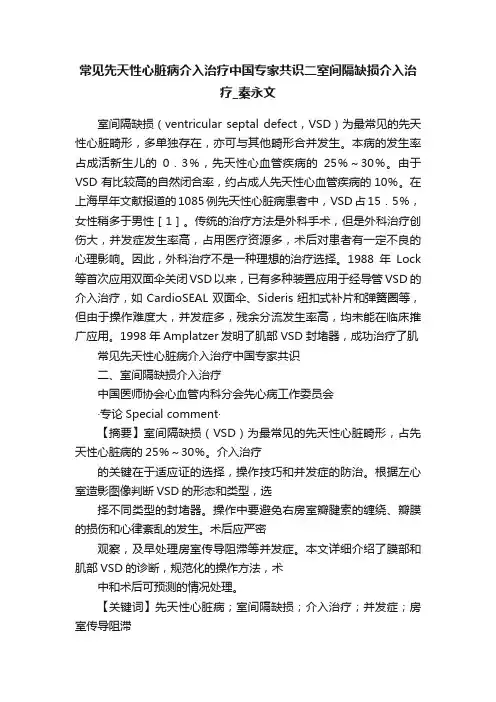
常见先天性心脏病介入治疗中国专家共识二室间隔缺损介入治疗_秦永文室间隔缺损(ventricular septal defect,VSD)为最常见的先天性心脏畸形,多单独存在,亦可与其他畸形合并发生。
本病的发生率占成活新生儿的0.3%,先天性心血管疾病的25%~30%。
由于VSD 有比较高的自然闭合率,约占成人先天性心血管疾病的10%。
在上海早年文献报道的1085例先天性心脏病患者中,VSD占15.5%,女性稍多于男性[1]。
传统的治疗方法是外科手术,但是外科治疗创伤大,并发症发生率高,占用医疗资源多,术后对患者有一定不良的心理影响。
因此,外科治疗不是一种理想的治疗选择。
1988年Lock 等首次应用双面伞关闭VSD以来,已有多种装置应用于经导管VSD 的介入治疗,如CardioSEAL双面伞、Sideris纽扣式补片和弹簧圈等,但由于操作难度大,并发症多,残余分流发生率高,均未能在临床推广应用。
1998年Amplatzer发明了肌部VSD封堵器,成功治疗了肌常见先天性心脏病介入治疗中国专家共识二、室间隔缺损介入治疗中国医师协会心血管内科分会先心病工作委员会·专论Special comment·【摘要】室间隔缺损(VSD)为最常见的先天性心脏畸形,占先天性心脏病的25%~30%。
介入治疗的关键在于适应证的选择,操作技巧和并发症的防治。
根据左心室造影图像判断VSD的形态和类型,选择不同类型的封堵器。
操作中要避免右房室瓣腱索的缠绕、瓣膜的损伤和心律紊乱的发生。
术后应严密观察,及早处理房室传导阻滞等并发症。
本文详细介绍了膜部和肌部VSD的诊断,规范化的操作方法,术中和术后可预测的情况处理。
【关键词】先天性心脏病;室间隔缺损;介入治疗;并发症;房室传导阻滞中图分类号:R541.1文献标志码:A文章编号:1008-794X (2011)-02-0087-06Interventional treatment of common congenital heart diseases:the common view of Chinese medicalexperts.Part Two———Interventional treatment of ventricular septal defect Committee on CongenitalHeart Diseases,Internal Medicine Branch of Cardiovascular Diseases,Chinese Physicians'Association.Corresponding author:ZHU Xian-yang,E-mail:xyang@yahoo.com.cn【Abstract】Ventricular septal defect(VSD)is the most common congenital heart disease,it accountsfor25~30%of all congenital heart diseases.The key points of interventional treatment for VSD are thecareful selection of indications,the rich experience in manipulating skill and the effective prevention of complications.According to the imaging findings on the selective left sided cardiography and echocardiography,the morphology and type of VSD,mainly including the precise size and location of thedefect,can be accurately determined,on this account the proper transcatheter device closure can berationally selected.During the interventional management,the twine and damage of the right atrio-ventricularvalve as well as its tendinous cords should be avoided,and the ventricular arrhythmias and new aortic ortricuspid regurgitation should be prevented.After the treatment,the patient should be closely observed,the postoperative complications such as atrioventricular blockshould be promptly dealt with.In this chapter,thediagnosis of membranous and muscular VSD,the standard interventional procedure of transcatheter deviceclosure implantation and the management of predictable events occurred during and after the procedure willbe systemically described.(J Intervent Radiol,2011,20:87-92)【Key words】congenital heart disease;interventional therapy;ventricular septal defect;complication;atrioventricular block作者单位:110016沈阳沈阳军区总医院先心病内科通信作者:朱鲜阳E-mail:xyangz@yahoo.com.cn部VSD,但是由于肌部VSD仅占VSD的1%~5%,临床应用数量有限。
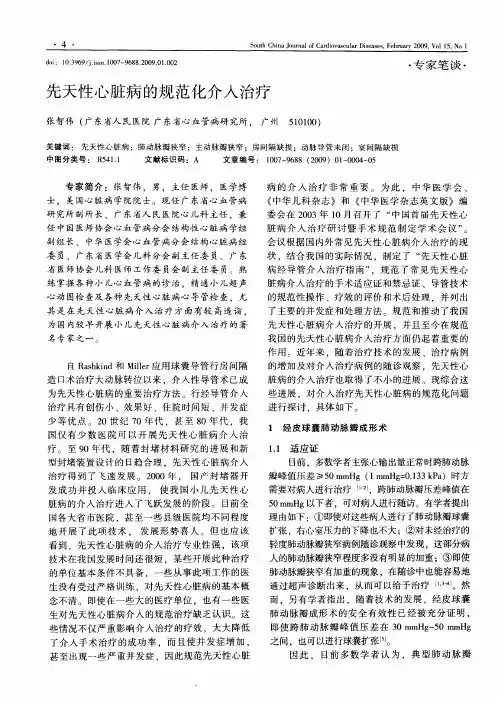
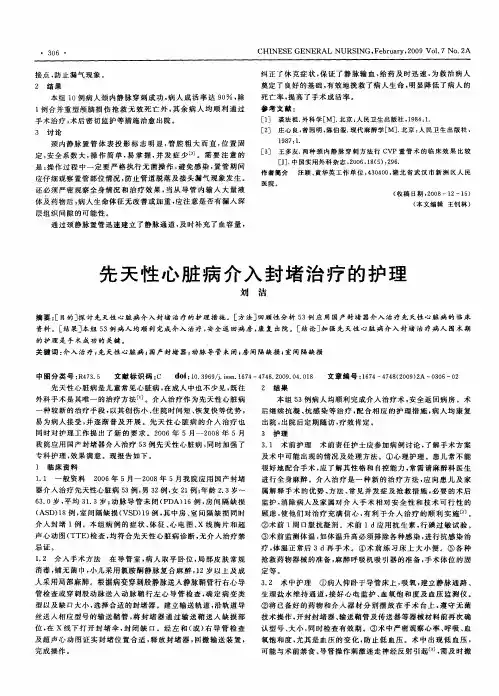
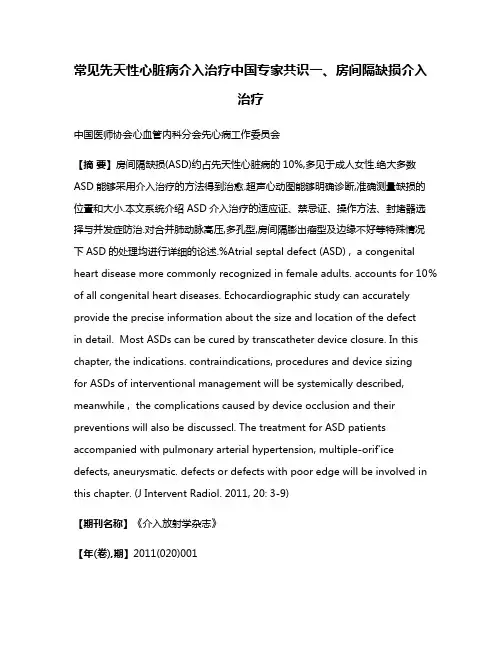
常见先天性心脏病介入治疗中国专家共识一、房间隔缺损介入治疗中国医师协会心血管内科分会先心病工作委员会【摘要】房间隔缺损(ASD)约占先天性心脏病的10%,多见于成人女性.绝大多数ASD能够采用介入治疗的方法得到治愈.超声心动图能够明确诊断,准确测量缺损的位置和大小.本文系统介绍ASD介入治疗的适应证、禁忌证、操作方法、封堵器选择与并发症防治.对合并肺动脉高压,多孔型,房间隔膨出瘤型及边缘不好等特殊情况下ASD的处理均进行详细的论述.%Atrial septal defect (ASD) , a congenital heart disease more commonly recognized in female adults. accounts for 10%of all congenital heart diseases. Echocardiographic study can accurately provide the precise information about the size and location of the defectin detail. Most ASDs can be cured by transcatheter device closure. In this chapter, the indications. contraindications, procedures and device sizingfor ASDs of interventional management will be systemically described, meanwhile , the complications caused by device occlusion and their preventions will also be discussecl. The treatment for ASD patients accompanied with pulmonary arterial hypertension, multiple-orif'ice defects, aneurysmatic. defects or defects with poor edge will be involved in this chapter. (J Intervent Radiol. 2011, 20: 3-9)【期刊名称】《介入放射学杂志》【年(卷),期】2011(020)001【总页数】7页(P3-9)【关键词】先天性心脏病;介入治疗;房间隔缺损;并发症【作者】中国医师协会心血管内科分会先心病工作委员会【作者单位】110016,沈阳,沈阳军区总医院先心病内科【正文语种】中文【中图分类】R541.1房间隔缺损(atrial septal defect,ASD)是指在胚胎发育过程中,房间隔的发生、吸收和融合出现异常,导致左、右心房之间残留未闭的缺损。



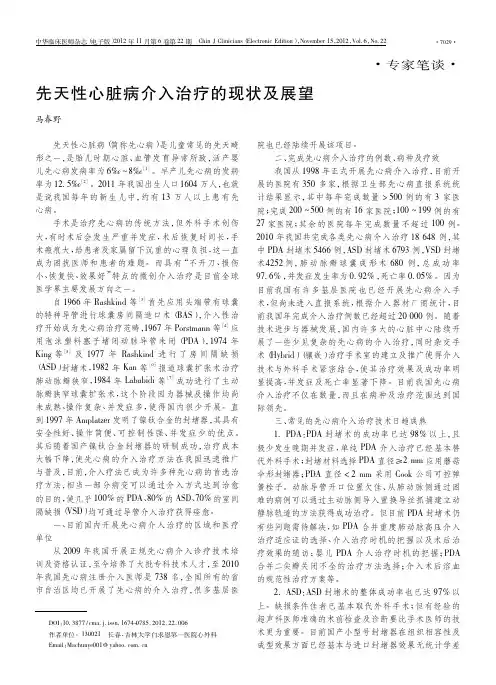
·专家笔谈·先天性心脏病介入治疗的现状及展望马春野DOI :10.3877/cma.j.issn.1674-0785.2012.22.006作者单位:130021长春,吉林大学白求恩第一医院心外科Email :Machunye001@yahoo.com.cn先天性心脏病(简称先心病)是儿童常见的先天畸形之一,是胎儿时期心脏、血管发育异常所致,活产婴儿先心病发病率为6ɢ 8ɢ[1]。
早产儿先心病的发病率为12.5ɢ[2]。
2011年我国出生人口1604万人,也就是说我国每年的新生儿中,约有13万人以上患有先心病。
手术是治疗先心病的传统方法,但外科手术创伤大,有时术后会发生严重并发症,术后恢复时间长,手术瘢痕大,给患者及家属留下沉重的心理负担,这一直成为困扰医师和患者的难题。
而具有“不开刀、损伤小、恢复快、效果好”特点的微创介入治疗是目前全球医学界主要发展方向之一。
自1966年Rashkind 等[3]首先应用头端带有球囊的特种导管进行球囊房间隔造口术(BAS ),介入性治疗开始成为先心病治疗范畴,1967年Porstmann 等[4]应用泡沫塑料塞子堵闭动脉导管未闭(PDA ),1974年King 等[5]及1977年Rashkind 进行了房间隔缺损(ASD )封堵术,1982年Kan 等[6]报道球囊扩张术治疗肺动脉瓣狭窄,1984年Lababidi 等[7]成功进行了主动脉瓣狭窄球囊扩张术,这个阶段因为器械及操作均尚未成熟、操作复杂、并发症多,使得国内很少开展。
直到1997年Amplatzer 发明了镍钛合金的封堵器,其具有安全性好、操作简便、可控制性强、并发症少的优点。
其后随着国产镍钛合金封堵器的研制成功,治疗成本大幅下降,使先心病的介入治疗方法在我国迅速推广与普及,目前,介入疗法已成为许多种先心病的首选治疗方法,相当一部分病变可以通过介入方式达到治愈的目的,使几乎100%的PDA 、80%的ASD 、70%的室间隔缺损(VSD )均可通过导管介入治疗获得痊愈。
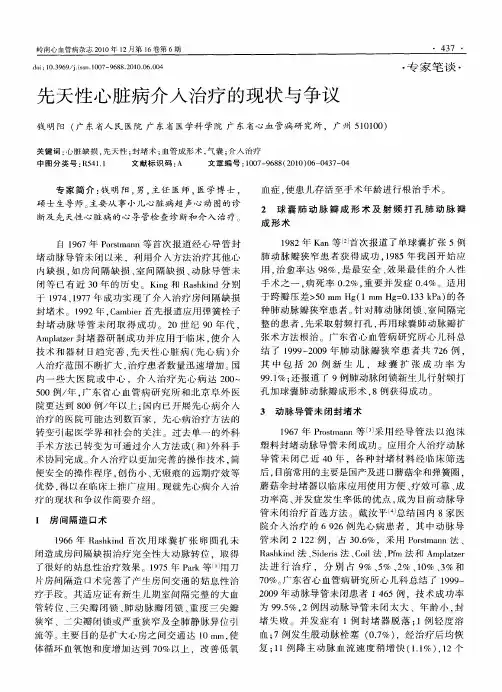

常见先天性心脏病介入治疗中国专家共识在我国先天性心脏病的发生率为0.7%~0.8%,每年新出生的先天性心脏病患儿约15万,是严重危害人们健康的疾病。
但是,大多数先天性心脏病能够通过矫治手术得到治愈,回归到社会的正常工作和生活中。
目前,每年有2万患者采用介入方法获得治疗,由于介入技术的迅速发展和介入器材的不断更新,使愈来愈多的医师和患者接受这种创伤小、恢复快与治疗效果明确的方法。
鉴于国内众多的不同设备和医疗水平的医院,以及参差不齐的医师技术手段严重的影响治疗结果与远期疗效,开展为了更好地总结经验,规范合理的治疗行为,提高先天性心脏病介入治疗的安全性,减少并发症的发生率,使先天性心脏病的介入治疗工作更加健康的发展,先天性心脏病工作委员会受中国心血管医师协会的委托,起草了常见先天性心脏病介入治疗的专家共识以供广大从事先天性心脏病介入治疗的医师借鉴。
动脉导管未闭介入治疗动脉导管未闭(patent ductusarteriosus,PDA)是常见的先天性心脏病之一,其发病率约占先天性心脏病的10%~21%,每2500~5000例存活新生儿中即可发生1例。
早产儿发病率明显增加,出生时体重<1kg者发病率可高达80%。
女性多见,男女比例约为1:3。
根据PDA直径的大小可有不同的临床表现,大多数的专家认为PDA一经诊断就必须进行治疗,而且大多能够通过介入方法治愈。
一、介入治疗适应证和禁忌证(一)适应证体重≥8kg,具有临床症状和心脏超负荷表现,不合并需外科手术的其它心脏畸形。
(二)相对适应证1.体重4~8 kg,具有临床症状和心脏超负荷表现,不合并需外科手术的其它心脏畸形;2.“沉默型”PDA;3.导管直径≥14mm;4.合并感染性心内膜炎,但已控制3个月;5.合并轻~中度二尖瓣关闭不全、轻~中度主动脉瓣狭窄和关闭不全。
(三)禁忌证1.感染性心内膜炎,心脏瓣膜和导管内有赘生物;2.严重肺动脉高压出现右向左分流, 肺总阻力>14woods;3.合并需要外科手术矫治的心内畸形;4.依赖PDA存活的患者;5.合并其它不宜手术和介入治疗疾病的患者。